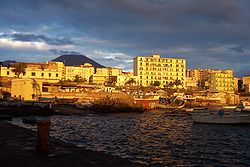Torre del Greco
| Torre del Greco | ||
|---|---|---|
| Comune | ||
| Metropolitan City of Naples | ||

Panorama of Torre del Greco
|
||
|
||
| Location of Torre del Greco in Italy | ||
| Coordinates: 40°47′N 14°22′E / 40.783°N 14.367°ECoordinates: 40°47′N 14°22′E / 40.783°N 14.367°E | ||
| Country | Italy | |
| Region | Campania | |
| Government | ||
| • Mayor | Ciro Borriello | |
| Area | ||
| • Total | 30.7 km2 (11.9 sq mi) | |
| Population (30 April 2009) | ||
| • Total | 87,575 | |
| • Density | 2,900/km2 (7,400/sq mi) | |
| Demonym(s) | Torresi or Corallini | |
| Time zone | CET (UTC+1) | |
| • Summer (DST) | CEST (UTC+2) | |
| Postal code | 80059, 80040 | |
| Dialing code | 081 | |
| Patron saint | Saint Januarius | |
| Saint day | September 19 | |
| Website | Official website | |
Torre del Greco (Italian pronunciation: [ˈtorre del ˈɡrɛːko]; ("Greek man's Tower") Neapolitan: Torre d' 'o Grieco) is a comune in the Metropolitan City of Naples in Italy, with a population of some 88,000 as of 2007[update]. The locals are sometimes called Corallini because of the once plentiful coral in the nearby sea, and because the city has been a major producer of coral jewellery and cameo brooches since the seventeenth century.
Historically part of Magna Graecia, the area was first colonised by ancient Greek settlers. In Roman times, Torre del Greco was probably a suburb of Herculaneum, characterised by patrician's villas. In 79 AD the eruption of Vesuvius buried the area under debris.
The Roman Villa Sora was a large and sumptuous residence, still overlooking the sea, which was buried and whose excavated remains can be seen today. It was built on multiple levels like the Villa of the Papyri and included quays on the shore. Many exquisite statues and frescos were found here in the Bourbon excavations of the 1700's which are now housed in the Palermo museum. Its size and quality implies it belonged to an important figure, possibly of the Imperial family. It was rediscovered in 1974 by the GAV Archaeological Group. Further excavations were done in 1989-92 which exposed more rooms and the remains visible today. It was found that the top floor collapsed following the eruption while the bottom floor was buried by the lava. The middle floor can be visited today.
On the beach not far from the villa are the remains of a Roman bath complex (Terme Ginnasi).
Later two villages are known to have been established in the area, Sora and Calastro. The Byzantine general Belisarius moved their inhabitants to Naples in 535. Around 700, it was also known as Turris Octava, the Latin for The Tower of Eight [sides] or The Eighth Tower, probably referring to a coastal watch tower. The current name appears for the first time in 1015; according to tradition, it stems from a Greek hermit who took up residence in the tower, or from the cultivation of a particular vine from Greece.
...
Wikipedia


